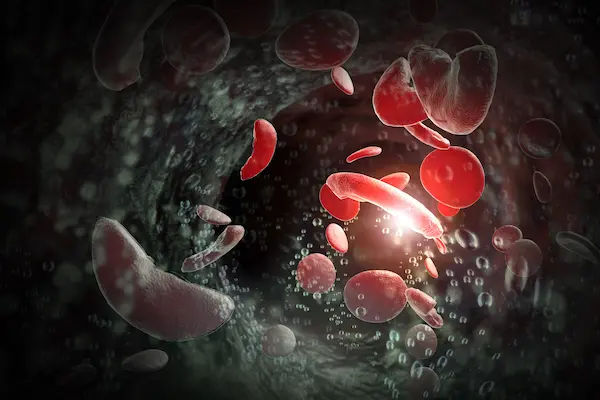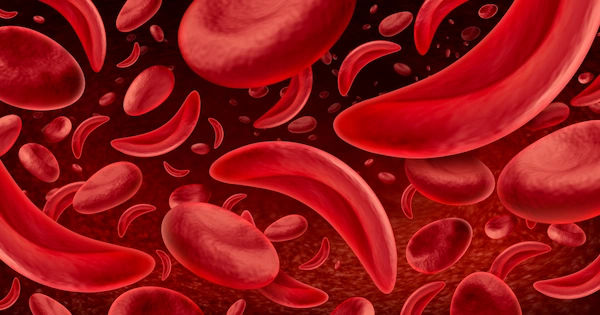Sickle Cell Anaemia: Understanding Symptoms, Causes, Diagnosis, And Treatment
Learn about sickle cell anaemia, its pathophysiology, symptoms, causes, diagnosis, and management. Explore more about its global impact and living with this blood disorder.

Written by Dr.Sonia Bhatt
Last updated on 3rd Jul, 2025

Introduction
Sickle cell anaemia is a lifelong blood disorder that causes abnormally shaped red blood cells. It is one of a group of inherited disorders known as sickle cell disease. It affects the shape of red blood cells, which carry oxygen to all parts of the body. Red blood cells usually are round and flexible. Hence, they move easily through blood vessels. However, some red blood cells are shaped like sickles or crescent moons in sickle cell anaemia. They also become rigid and sticky, which can slow or block the blood flow and might lead to severe health complications. It was first identified in 1910 and has been extensively studied over the years, which has led to improved understanding and management.
Difference Between Sickle Cell Anaemia and Sickle Cell Disease
Sickle cell anaemia is a type of sickle cell disease, an inherited blood disorder that affects the red blood cells. It is the most common and severe type of sickle cell disease, and may result in an abnormality in the oxygen-carrying protein haemoglobin found in red blood cells. On the other hand, sickle cell disease is a group of inherited blood disorders that affect red blood cells. It can include sickle cell anaemia, sickle C and sickle thalassaemia. It can lead to anaemia, which can cause jaundice, fatigue, dizziness, irritability, and lightheartedness.
Global Impact and Prevalence of Sickle Cell Disease
Research says sickle cell disease affects more than 100,000 people in the United States and 8 million worldwide. In the United States, 9 to 10 people who have sickle cell disease are of African ancestry or identify as Black. Research further reveals that 1 in 13 Black babies are born with sickle cell trait, inheriting a sickle cell gene from one parent. Additionally, about 1 in every 365 Black babies is born with sickle cell disease, inheriting a sickle cell gene from one parent.
Understanding Sickle Cell Anaemia’s Prevalence Globally
Sickle cell anaemia is most prevalent in sub-Saharan Africa, the Middle East, and parts of India, affecting millions annually. Migration patterns have also increased its prevalence in Europe and North America. This condition can disproportionately affect individuals of African, Middle Eastern, Mediterranean, and Indian descent. Understanding these demographics will help tailor prevention and treatment programmes.
Pathophysiology of Sickle Cell Anaemia
The pathophysiology of sickle cell anaemia is rooted in genetic mutations and their impact on red blood cells. Understanding this process is essential for developing effective treatments for the condition.
Inheritance Patterns and Genetic Basis
Sickle cell anaemia is an inherited disorder in an autosomal recessive pattern, requiring both parents to carry the defective gene. Mutations in the HBB gene can result in the production of abnormal haemoglobin, known as haemoglobin S.
Complications Caused by Sickle-Shaped Red Blood Cells
Sickle-shaped cells are rigid and sticky, leading to blockage in blood vessels. This obstruction reduces oxygen delivery to tissues, causing organ damage, pain and other complications such as acute chest syndrome and stroke.
Causes of Sickle Cell Anaemia
Sickle cell anaemia is caused by a change in the gene that tells the body to make haemoglobin. Haemoglobin is an iron-rich compound in red blood cells that allows these cells to carry oxygen from the lungs to all other parts of the body. With one typical haemoglobin gene and one sickle cell gene, people with the sickle cell trait can make both typical haemoglobin and sickle cell haemoglobin. Their blood might contain some sickle cells, but they generally don’t have symptoms. They are the carriers of the disease, meaning they can pass the gene to their children.
Symptoms of Sickle Cell Anaemia
Symptoms of sickle anaemia can usually appear around 6 months of age. They vary from person to person and may even change over time.
Symptoms include the following:
Extreme Pain
Individuals can experience periodic episodes of extreme pain called pain crises. Pain develops when sickle-shaped red blood cells block blood flow through tiny blood vessels to the chest, joints, and abdomen.
Anaemia
Sickle cells break apart easily and die. Typical red blood cells usually live for about 120 days before they need to be replaced. But sickle cells usually die in 10 to 20 days, resulting in a shortage of red blood cells, which is known as anaemia.
Infections
The spleen is important for protecting against infections, but sickle cells can damage the spleen, raising the risk of developing infections. To prevent potentially life-threatening infections such as pneumonia, babies, and children with sickle cell anaemia are usually given vaccinations and antibiotics.
Vision Problems
With sickle cells, tiny blood vessels that supply blood to the eyes can become plugged, damaging the portion of the eye that processes visual images called the retina. This can lead to vision problems.
Delayed Growth or Puberty
A shortage of healthy red blood cells can slow growth in babies and children and delay puberty in teenagers.
Swelling of Feet and Hands
Sickle-shaped red blood cells block blood circulation in the hands and feet, causing them to swell.
Get You Symptoms Checked By Top Doctors
Risks and Complications Associated with Sickle Cell Anaemia
Sickle cell anaemia can lead to a host of complications, some of which include:
Acute Chest Syndrome
Sickle cells blocking blood vessels in the lungs or a lung infection can cause life-threatening complications. These might also require emergency medical treatment.
Stroke
Sickle cells can block blood that flows to the brain. Signs of stroke include weakness or numbness of the arms and legs, weakness, seizures, speech difficulties and loss of consciousness.
Pulmonary Hypertension
People with sickle cell anaemia can develop high lung blood pressure, usually affecting adults. Fatigue and shortness of breath are common symptoms of this condition, which can be fatal.
Organ Damage
Sickle cells block blood flow to the organs and deprive the affected organs of blood and oxygen. In sickle cell anaemia, the reduced amount of blood in oxygen can damage organs and nerves, including the liver, kidneys, and spleen, and can be fatal.
Pregnancy Complications
Sickle cell anaemia can increase the risk of high blood pressure and blood clots during Pregnancy. It can also increase the risk of miscarriage, low birth weight babies, and premature birth.
Diagnosis of Sickle Cell Anaemia
Early and accurate diagnosis of sickle anaemia is essential for effectively managing and preventing complications.
Screening and Diagnostic Tests
Common diagnostic methods include newborn screening, haemoglobin electrophoresis and genetic testing. Early screening programmes are crucial in regions with high prevalence.
Importance of Early Detection
Early diagnosis allows timely intervention, reducing complications and improving the quality of life. It enables patients and healthcare providers to implement early preventive measures.
Management and Treatment Options
Management of Sickle cell anaemia includes medical interventions and supportive care tailored to individual needs.
Blood Transfusions and Bone Marrow Transplants
Regular blood transfusions prevent complications such as stroke, while bone marrow transplants offer a potential cure. Advances in transplantation techniques have also improved success rates significantly.
Current Treatment Options
Hydroxyurea helps reduce the frequency of sickle cell crises and the need for blood transfusions. Preventive antibiotics, pain management, and regular health check-ups are also essential components of care.
Living with Sickle Cell Anaemia
To prevent sickling episodes, patients are advised to avoid extreme temperatures, manage stress, stay hydrated, and maintain a healthy diet. Adequate rest and regular exercise are also beneficial. Counselling, support groups, and healthcare resources provide emotional and psychological support to patients and families, enhancing their coping mechanisms and quality of life.
Conclusion
Sickle cell anaemia is a complex and challenging inherited blood disorder. Raising awareness, promoting early diagnosis, and enhancing access to effective treatments such as bone marrow transplants play crucial roles in improving patient outcomes.
Consult Top Doctors
Get You Symptoms Checked By Top Doctors

Dr. Dhanraj K
General Physician/ Internal Medicine Specialist
25 Years • MBBS, MD Internal Medicine - Osmania Medical College, Hyderabad
Hyderabad
Apollo Hospitals Jubilee Hills, Hyderabad
(400+ Patients)

Dr. Gunashree V L
General Physician/ Internal Medicine Specialist
3 Years • MBBS
Bengaluru
Apollo Clinic, JP nagar, Bengaluru

Dr. Harshendra Jaiswal
General Physician/ Internal Medicine Specialist
12 Years • MBBS , MD (General medicine)
Kolkata
108 DHANA DHANVANTARI Clinic, Kolkata
(25+ Patients)

Dr. Swagata Sircar
General Physician/ Internal Medicine Specialist
8 Years • MBBS, MD General Medicine
Kolkata
HealthYou Speciality Clinic & Diagnostics., Kolkata

Dr Syed Mateen Pasha
General Physician
2 Years • MBBS
Bengaluru
PRESTIGE SHANTHINIKETAN - SOCIETY CLINIC, Bengaluru
Consult Top Doctors

Dr. Dhanraj K
General Physician/ Internal Medicine Specialist
25 Years • MBBS, MD Internal Medicine - Osmania Medical College, Hyderabad
Hyderabad
Apollo Hospitals Jubilee Hills, Hyderabad
(400+ Patients)

Dr. Gunashree V L
General Physician/ Internal Medicine Specialist
3 Years • MBBS
Bengaluru
Apollo Clinic, JP nagar, Bengaluru

Dr. Harshendra Jaiswal
General Physician/ Internal Medicine Specialist
12 Years • MBBS , MD (General medicine)
Kolkata
108 DHANA DHANVANTARI Clinic, Kolkata
(25+ Patients)

Dr. Swagata Sircar
General Physician/ Internal Medicine Specialist
8 Years • MBBS, MD General Medicine
Kolkata
HealthYou Speciality Clinic & Diagnostics., Kolkata

Dr Syed Mateen Pasha
General Physician
2 Years • MBBS
Bengaluru
PRESTIGE SHANTHINIKETAN - SOCIETY CLINIC, Bengaluru
.webp)


